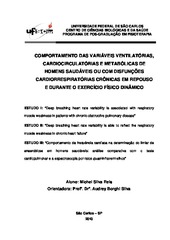Comportamento das variáveis ventilatórias, cardiocirculatórias e metabólicas de homens saudáveis e com disfunções cardiorrespiratórias crônicas em repouso e durante o exercício físico dinâmico
Abstract
Patients with chronic heart failure (CHF) and chronic obstructive pulmonary disease (COPD) present significant exertional dyspnea. The peripheral muscle dysfunction appears to be the greatest impact on the inability to perform physical exercise. Additionally, there is respiratory muscle weakness caused by a limited supply of O2 and alteration of mechanical ventilation. In this context, in order to better understand the manifestations of these disorders and to establish management strategies, we have proposed the development of three studies. The first study was entitled Deep breathing heart rate variability is associated with respiratory muscle weakness in patients with chronic obstructive pulmonary disease . The purpose of the present investigation was to evaluate the influence of respiratory muscle strength on autonomic control of heart rate variability (HRV) in these patients. Ten COPD patients (69±9 years; forced expiratory volume in the first second (FEV1)/forced vital capacity (FVC) 59±12% and FEV1 41±11% predicted) and nine age-matched healthy male volunteers (64±5 years) participated in this study. The maximal inspiratory pressure was obtained in the sitting position. Then, electrocardiography signal was obtained in three conditions: 1) lying position for 15 min; 2) lying position during the respiratory sinusal arrhythmia maneuver (RSA-M) for 4 min; and 3) sitting position for 15 min. Data was analyzed by the time (RMSSD and SDNN indexes) and the frequency domains, in total power, low frequency (LF), high frequency (HF) absolute (ab) and normalized (nu) units and LF/HF ratio. Regarding the RSA-M indexes, the expiratory/inspiratory ratio (E/I) and the inspiratory/expiratory difference (ΔIE) were calculated. The patients with COPD demonstrated significantly impaired cardiac autonomic modulation at rest and during RSA-M when compared with healthy subjects (ratio E/I: 1.1±0.06 vs. 1.2±0.1 e ΔIE: 7.0±3.5 vs 12.7±4.2, respectively). Moreover, significant and positive correlations between maximal inspiratory pressure (MIP) and the inspiratory-expiratory difference (ΔIE) (r = 0.60, p<0.01) were found. In conclusion, patients with COPD presented impaired sympathetic-vagal balance at rest and during RSA-M. In addition, cardiac autonomic control of heart rate was associated with inspiratory muscle weakness in chronic obstructive pulmonary disease. Based on this evidence, future research applications of respiratory muscle training may bring to light a potentially valuable target for rehabilitation. The second study was entitled to Deep breathing heart rate variability xviii is able to reflect the respiratory muscle weakness in chronic heart failure . The purpose of the present investigation was to evaluate the influence of respiratory muscle strength on autonomic control in these patients. Ten CHF (62 ± 7 years left ventricle eject fraction of 40 ± 5% and NYHA class I-III) and nine matched-age healthy volunteers (64±5 years) participated in this study. Heart rate variability (HRV) was obtained at rest and during RSA-M by electrocardiograph (as previously described). CHF patients demonstrated impaired cardiac autonomic modulation at rest and during RSA-M when compared with healthy subjects (p<0.05). Moreover, significant and positive correlations between MIP and IE-differences (r: 0.79), E/I ratio (r: 0.83), RMSSD (r: 0.77), SDNN (r: 0.77), LFab (r: 0.77), HFab (r: 0.70) were found during RSA-M. At rest, significant correlations were also found. Patients with CHF presented impaired sympathetic-vagal balance at rest. In addition, cardiac autonomic control of heart rate was associated with inspiratory muscle weakness in CHF. Based on this evidence, recommendations for future research applications of respiratory muscle training can bring to light a potentially valuable target for rehabilitation. Finally, the third study: "Behavior of heart rate on determination of anaerobic threshold in healthy men: comparison with cardiopulmonary exercise testing and near-infrared spectroscopy" aimed to identify the anaerobic threshold (AT) obtained from the V-slope method , visual method on oxihemoglobin (O2Hb) and deoxihemoglobin (HHb) and compare the method with heteroscedastic (HS) applied to VCO2, HR and HHb data. Secondly, to assess the degree of agreement between the methods for determination of AT. Fourteen healthy men were subjected to incremental cardiopulmonary test (CPT) in the electromagnetic cycle-ergometer until physical exhaustion. At the same time they obtained the following biological signals: (i) ventilatory and metabolic variables - a breath to breath - measured by the Cardio2 System (Medical Graphics Corporation, St. Paul, MO, USAI), (ii) spectroscopy, quasiinfrared rays - NIRS (NIRO 300 - Hamamatsu Photonics, Japan), and (iii) heart rate through cardiofrequencymeter (Polar S810i). We observed temporal equivalence and similar values of power (W), absolute O2 consumption (mL/min) and relative O2 consumption (mL/kg/min) and HR (bpm) on determination of AT by the methods performed. In addition, by the Bland-Altman plot, HR (bpm) confirmed the good agreement between the methods with biases between -1.3 and 3.5. In conclusion: (i) all methods were sensitive in identifying the AT1, including the HS applied to FC, and (ii) the methods showed a good correlation in the identification of AT1. Thus the xix results support the FC, a methodology that is simple and economically feasible, seems to be a valid parameter in determining the AT of the individuals in our study. Therefore it remains to be clarified if these results can be replicated in patients with chronic cardiopulmonary disorders, contributing in safe, individualized and adequate prescribing physical exercise in rehabilitation programs.
